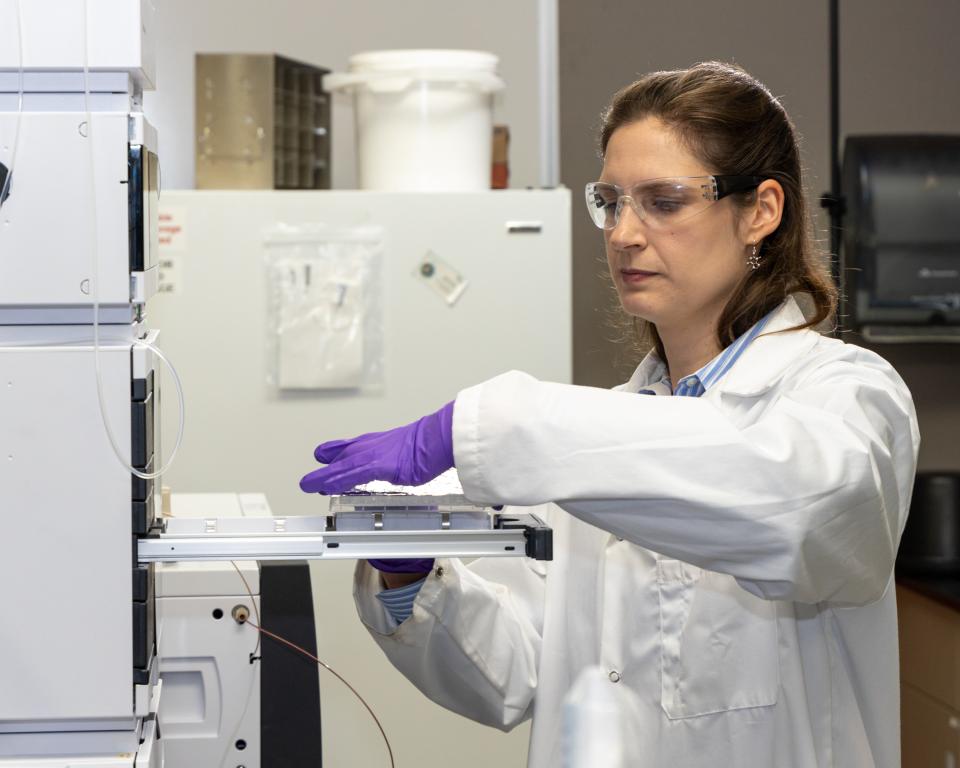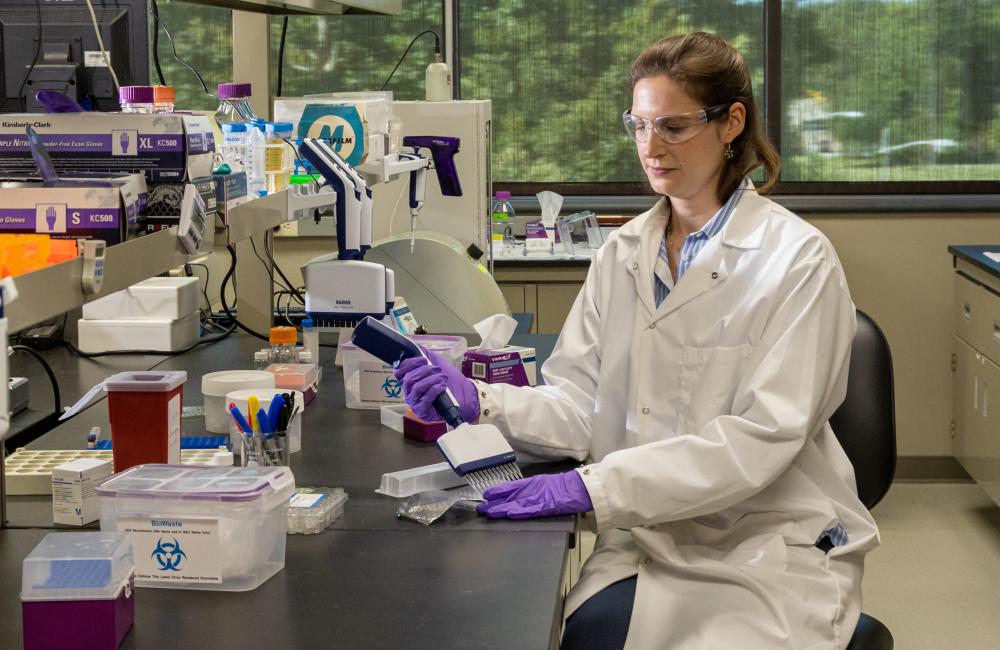Early career scientist Stephanie Galanie has applied her expertise in synthetic biology to a number of challenges in academia and private industry. She’s now bringing her skills in high-throughput bio- and analytical chemistry to accelerate research on feedstock crops as a Liane B. Russell Fellow at Oak Ridge National Laboratory.
Galanie is outfitting a new analytics lab at ORNL to accommodate the work she leads, using specialized equipment to characterize thousands of samples at a time to determine which molecules are involved in desired traits in a particular plant. The research will help accelerate the work of selecting or breeding plants to flourish under marginal growing conditions. This is a key task of scientists at the U.S. Department of Energy’s Center for Bioenergy Innovation (CBI) headquartered at ORNL. CBI is engaged in research to accelerate domestication of bioenergy-relevant plants and microbes to enable co-product development at multiple points in the bioenergy supply chain.
“With an increase in DNA and RNA sequencing over the last 20 years, we now have massive amounts of data,” Galanie said. “The question is, how do we take that sequence information and figure out what it means and what to do about it?”
Her work supports CBI’s mission to create feedstock crops that can grow on non-agricultural lands and withstand pests, pathogens, and poor growing conditions. The methods Galanie used in private industry can speed the screening of plant genes at the biochemical level to identify those genes that help meet key specifications. Galanie’s methods can also accelerate efforts to identify microbial genes that deconstruct and convert plant biomass to fuels and products.
Galanie earned her PhD in chemistry and M.S. in bioengineering at Stanford University in California. She capped off her academic career working on a groundbreaking project that genetically engineered yeast to produce opioids. The work, detailed in Science, holds promise for the creation of cheaper, faster methods to produce targeted painkillers with less addictive properties.
The sweet life

Galanie found her skillset in high demand after graduation, and immediately took on a research and development scientist position in the biochemistry group at Codexis, a protein engineering company in the San Francisco Bay Area. Over the next three years, she honed her skills in high-throughput science and led development of biochemical assays and analytical methods for directed evolution of enzymes used as biocatalysts in pharmaceuticals, foods, and beverages. She helped develop an enzyme platform that resulted in the introduction of a new stevia-based sweetener, TASTEVA® M, to the marketplace with collaborator Tate & Lyle.
“To many consumers, previous stevia-based sweeteners had a licorice aftertaste. We developed an enzyme to target a natural compound in stevia and produce a sweetener without that aftertaste, while maintaining high-potency sweetening,” she explained.
“My work has centered around new approaches to discover enzymes and natural product pathways, and that’s one reason I came to Oak Ridge—to pursue that kind of basic research,” Galanie said. “Accelerative science is a big emphasis in the CBI research program and being engaged in a large research enterprise is another reason I’m here.”
She was also drawn by ORNL’s capabilities and shared expertise. Among the equipment in her lab is a new triple-quadrupole mass spectrometer, giving scientists the ability to analyze hundreds of molecules in thousands of samples in a single run.
“The national lab environment is a cross between academia and industry, and that appeals to me,” she said. “At Oak Ridge, we have deep expertise in a number of areas and work in a team-based environment performing a lot of exploratory science.”
In the Metabolomics and Bioconversion Group at the lab she works alongside specialists within the group and other colleagues in the Biosciences Division who have expertise in plant phenotyping and physiology, which helps inform an understanding of important molecular processes. For example, computational biologists at the lab “integrate all the sets of -omics data from genome-wide association populations and contribute to the understanding of which metabolic phenotypes are significant so I can start piecing together the pathways via chemical logic. Through CBI we have other experts in enzyme ligand docking who can help us understand the biophysics of what we’re observing experimentally. It’s a great environment for our interdisciplinary pursuits.”
An inquisitive engineer
Growing up, Galanie’s family moved frequently as her father served in the Navy as an aviator. After his retirement, the family settled in Maryland, where her father took on a role as program manager at Johns Hopkins’ applied physics lab. During her high school years, Galanie benefited from supportive parents and teachers who encouraged her natural inquisitiveness and provided opportunities for scientific experimentation.
As an undergraduate at the University of Maryland, Galanie started out in chemical engineering, but switched majors after developing an interest in biochemistry. She earned dual degrees in biochemistry and cell biology, and participated in interdisciplinary, multi-institutional team research. “My dad thought I should be an engineer, and in a way I am—a very questioning engineer,” Galanie said.
“I like to have diversity in my research, and Oak Ridge was appealing for that reason. I also like DOE’s and CBI’s mission in sustainability, which is important to me. Being able to work in sustainability is very motivating,” Galanie said.
Since moving to Tennessee only nine months ago, Galanie has enjoyed hiking the many parklands in East Tennessee. At a recent CBI meeting in Asheville, N.C., she presented her first high-throughput results and got to know colleagues on the CBI team from other institutions across the country. She also took the opportunity to explore some nearby trails.
Her advice for young scientists is to “be more curious than you are scared. Write that email. Ask those questions. Those questions will either lead nowhere or someplace interesting and curiosity-satisfying.”
ORNL is managed by UT-Battelle for the DOE’s Office of Science, the single largest supporter of basic research in the physical sciences in the United States. DOE’s Office of Science is working to address some of the most pressing challenges of our time. For more information, please visit https://energy.gov/science.


